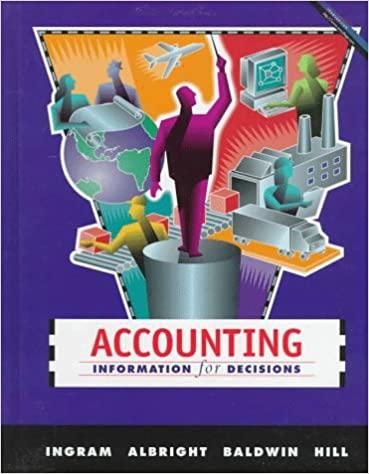Question
Over the period 2014 through 2018, the two largest assets have been merchandise inventory and property, net of accumulated depreciation. Property declined from 63.2% in
Over the period 2014 through 2018, the two largest assets have been merchandise inventory and property, net of accumulated depreciation. Property declined from 63.2% in 2014 to 53.4% in 2018; the decreases were caused by closure of stores and depreciation of the long-lived assets; the decrease to 58.0% of total assets in 2016 was also caused by increases in other assets such as goodwill despite the increase of almost $400 million in the property account; in 2017 and 2018 there were small monetary decreases but the percentage decreases were magnified by increases in primarily inventory. Lowes statement of cash flows shows the lowest capital expenditures of $880 million in 2014 but increased to $1.1 to $1.2 billion in the four most recent years as Lowes responded to the improving economy and has attempted moderate growth in property, plant and equipment investments in the most recent years. Prior to the collapse of the housing market, Lowes was opening over 100 stores a year in the early through mid-2000s.
Merchandise inventories have ranged from a low of 28.1% in 2014 to a high of 36.4% in 2018; inventory rose over the five-year period due to the decision to offer customers greater inventory selection, the improving economy, and opening more stores. The merchandise inventory was a significantly larger percentage of total assets in 2018; this was the result of a decrease in other assets such as property as well as carrying more inventory on hand.
The third largest asset was other noncurrent assets in 2014 and 2015; in 2014 noncurrent assets were 4.3% of total assets before decreasing in 2015 to 1.6%. In 2018, other noncurrent assets were again the third largest asset at 2.9%. Goodwill, an intangible asset increased to 3.1% in 2016 making it the third largest asset; this asset increased from 0.5% in 2015 due to the acquisition of RONA. Goodwill increased again to 3.7% in 2017 due to acquisition of Maintenance Supply Headquarters. Lowes is pursuing growth by acquiring existing companies while expanding Lowes stores at a moderate pace. Goodwill decreased to 0.9% of total assets in 2018 due to the impairment of goodwill connected to Canada-Retail and Canada-Distribution; the write off was $952 million reducing goodwill to $303 million by the end of fiscal year 2018 for other acquired subsidiaries such as Maintenance Supply Hardware. Over the entire five-year period, Lowes three largest assets ranged from a low of 91.5% of the companys total assets in 2016 to a high of 95.6% in 2014; the total increased to 92.7% in 2018 primarily due to growth in inventory.
Lowes largest asset is property which consists of land, buildings and building improvements, equipment and construction in progress according to footnote 7 on page 59 of the Lowes Companies, Inc. 2018 Annual Report. The stores and warehouses are critical assets in generating revenue as they house the inventories and provide retail space where customers can shop for the products they want. Merchandise inventory represents the products Lowes purchased from vendors and offers for sale to customers; inventory consists of construction materials, yard and garden products, hardware, tools, home improvement products, appliances, outdoor power equipment, etc. A typical Lowes store carries approximately 34,000 items according to page 2 of the annual report.
Other noncurrent assets consist of several assets and as identified in the annual report are primarily comprised of equity method investments, net carrying amount of excess properties, intangible assets including trademarks and dealer relationships, and extended protection plans deferred costs. Goodwill is an intangible asset which has an indefinite life and is therefore not amortized; it represents the excess of the purchase price above the fair value of the net assets of companies acquired by Lowes. Lowes evaluates goodwill annually for impairment and according to page 47, $952 million of impairment charges were recognized in 2018. Goodwill increased in 2016 as a result of the acquisition of RONA by $976 million which was allocated between Canada Retail and Canada Distribution while most of the impairment in 2018 was due to these two subsidiaries as mentioned previously.
Lowes keeps the companys cash and cash equivalents balances quite low. Due to aggressive cash management practices, Lowes keeps just enough cash on hand to cover operating costs. Lowes has negotiated long term and short term borrowing agreements with creditors that allow the company to borrow funds quickly at a predetermined interest rate. Therefore, Lowes has quick access to funds if needed. This arrangement with creditors allows the company to have sufficient cash at each year end, however, the companys access to cash for any financial needs outside of regular operating costs relies on creditor financing.
Lowes Three Largest Liabilities
|
| 2018 | 2017 | 2016 | 2015 | 2014 |
| Long Term Debt | 41.7% | 44.1% | 41.8% | 36.9% | 34.1% |
| Accounts Payable | 24.0% | 18.7% | 19.3% | 18.0% | 16.2% |
| Other Current Liabilities | 7.0% | 5.5% | 5.7% | 5.9% | 6.1% |
| Total | 72.7 | 68.3 | 66.9 | 60.9 | 56.3 |
Describe what types of transactions created these liabilities and what items would be included in these amounts based on information provided in the annual report and text.
Step by Step Solution
There are 3 Steps involved in it
Step: 1

Get Instant Access to Expert-Tailored Solutions
See step-by-step solutions with expert insights and AI powered tools for academic success
Step: 2

Step: 3

Ace Your Homework with AI
Get the answers you need in no time with our AI-driven, step-by-step assistance
Get Started


